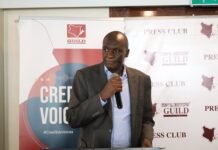By Wahinya Henry
Nairobi, Kenya: Seven years ago Jane Achieng Nyabuti, on a chilly morning, inhaled fresh air as she went downhill along the valley road.
Achieng was optimistic about a fulfilling day at the National Social Security Fund (NSSF) where she worked.
Then without notice, her left leg locked at the knee joint. Next was severe pain. Jane was not able to walk. Good Samaritans stepped in to assist.
The retired mother of four told Talkafrica at the Kenyatta National Hospital (KNH) physiotherapy department before she dashed to the gym for the exercise to try to figure out the cause of the lock.
But it was in vain.
Her memory flashed back and she remembered the often description given in the village by the aged – I realized that grease ya magoti yangu imekwisha – translated loosely – means the synovial fluid of the joint had ceased.
“It reduces with age and causes the cracking of a knee joint” explains the head of the physiotherapy unit at KNH, Kennedy Mogire, adding:
“Wear and tear of the joint surface leading to inflammation of the joint.”
Jane is among more than 520 million people in the world living with osteoarthritis (OA) – osteo (of the bone), athr (joint), and itis (inflammation).
In a global study by World Physiotherapy, the global body for national physiotherapy associations, of 291 conditions, hip and knee OA was ranked as the 11th highest contributor to disability.

According to the National library of medicine report – national center for biotechnology information, Hip and knee OA is one of the leading causes of global disability.
Methodological issues within this study make it highly likely that the real burden of OA has been underestimated.
With the aging and increasing obesity of the world’s population, health professionals need to prepare for a large increase in the demand for health services to treat hip and knee OA, says the report.
Mogire notes that Osteoarthritis is the most common joint condition. It can have serious impact on a person.”
Jane bade goodbye to the house and other chores after the knee the left knee locked.
“I was not able to climb up the stairs because of panting. Prolonged pain at night became a norm. My weight increased to nearly 120 kilos,” she says.
As Jane looks forward to teaming up with the rest of the population to celebrate World Physiotherapy Day on September 8, she recalls visits to several hospitals failed to deliver relief.
That was before a friend referred her to the KNH physiotherapy unit where she was put on a three-day-per-week exercise program that has resulted in marked improvement.
“This was a breakthrough in my suffering. They walked the whole journey with me. My weight came down to below 100 kilos,” said Jane as she worked at the gym.
According to Masika, OA which is a form of arthritis can be caused by old age, female gender obesity, or even joint injury while primary OA which constitutes 95 percent of the cases comes with old age.
“It usually affects just a few joints like joints of the hands, knee hips spine,” says Masika.
Secondary) A is less than 5 percent of the cases and especially among the young population.
There is a predisposing – previous trauma, congenital deformity, systemic disease, or marked obesity.
Management
Senior Physiotherapist at the Unit, Wycliffe Iyadi Tatayo describes OA as a form of arthritis, a condition that causes pain, joint suffering, and swelling of the joint.
According to Iyadi says there are two major types of OA – secondary where the case is known and the other is of unknown cause – both that those affected should seek medical attention early
“A tendency to buy drugs like pain killers over the counter has been abused. They come for treatment late. Proper treatment schedule and diagnosis is key” says Iyadi.
He lists gout associated with roast meat and alcohol and rheumatoid in which the body’s immune system fights against normal cells as two other common arthritis.














